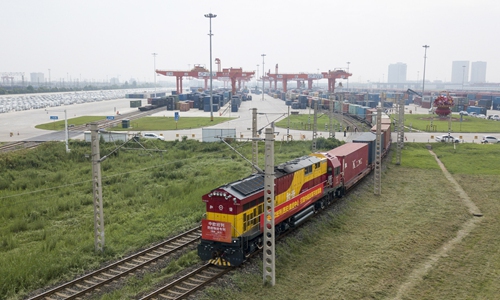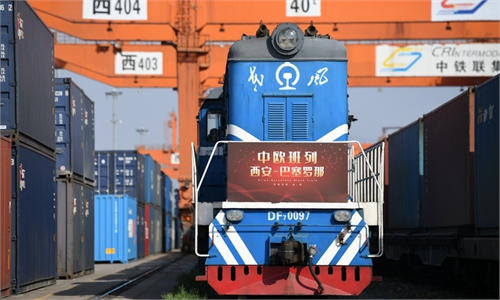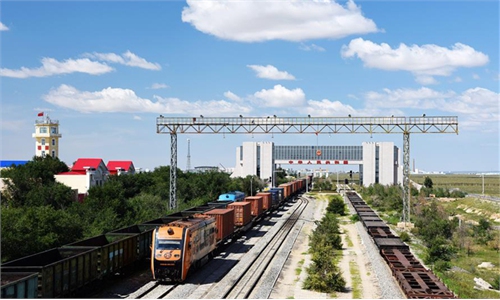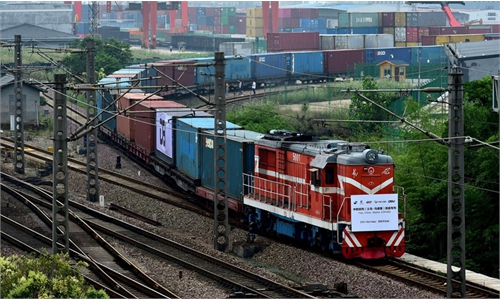A 105% record growth reflects BRI’ s resilience in hard time
China-Europe rail freight bucks trends amid unprecedented logistic hurdles
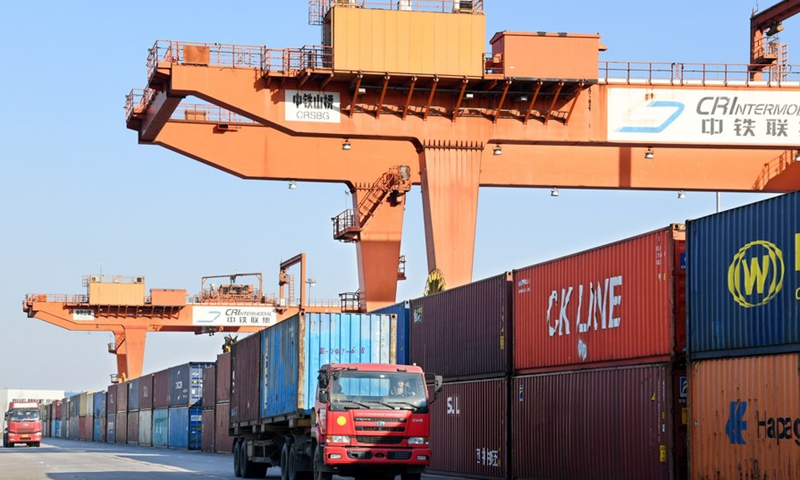
A truck hauling containers passes the freight yard of the multimodal transport center in the China-Shanghai Cooperation Organization (SCO) local economic and trade cooperation demonstration zone in Qingdao, east China's Shandong Province, Nov. 9, 2020. (Photo: Xinhua)
A train fully loaded with goods gradually departs Yiwu West Station, the world's 'supermarket' Yiwu, East China's Zhejiang Province, and heading toward its final destination in Madrid, Spain, 13,000 kilometers away. This is the third train departing from the station in a day, while it used to be just once in a day or in days. Despite the global pandemic and disruptions, the China-Europe freight train, as the land envoy of the Belt and Road Initiative (BRI), has significantly bucked the trend and operated in full swing providing markets across the Eurasian continent much-needed goods and products, from preventative masks to home appliances from factories in South China to stores of countries along the route.
Total freight on trains between China and Europe has grown nearly 105 percent this year compared with the last year, with growth nearly doubling in the first half of the year, according to the latest figure by the Yiwu Customs, marking an unprecedented growth rate since its launch, another demonstration of the resilience of the BRI progress despite coronavirus-caused headwinds. Since the outbreak, around 120 trains were dispatched per month from Yiwu to Europe, which means 3-4 trains per day on average.
To Zhao Hengchao, a director with the port customs at Yiwu West Train Station, who has been in the position for many years, the change in traffic flow has been conspicuous, especially given ocean transport has been impacted by the shortage of containers and air freight by restrictive prices. "Last year, around 100 trains departed from Yiwu West Railway Station from January to August and 400 trains from August to December, and now there are at least 50-70 trains every month, reflecting the demand for land transportation," said Zhao.
While shipping is down by a third this year and airfreight is bursting and prices are high, the freight rate of the China-Europe freight train has not gone up in a year despite the booming demand, said Zhao, noting that the stable price and timely delivery making the freight train more competitive than other transports, especially in the special period.
Growing in hard time
The booming demand for the rail freight in Yiwu is just the tip of the iceberg for a growing trade channel.
Between January to November, the number of cross-border freight trains, standard boxes and the total value of goods at the Manzhouli port in Inner Mongolia Autonomous Region, located on the Russian border recorded an increasing total, with a total of 2,793 trains running, a year-on-year growth of 40.85 percent, delivering 242,760 TEUs, a 45.24 percent increase year-on-year, according to the latest data that Manzhouli Customs sent to the Global Times.
From a national perspective, between January and November, around 11,270 China-Europe freight trains ram between the continents, a year-on-year increase of 51 percent. The proportion of return and departure trips reached 76 percent, with the heavy container rate reached 98 percent, according to the report that China Railway Container Transport Co sent to the Global Times.
"At present, most of the products exported through the freight train are highly value-added ranging from finished automobiles and auto parts to raw materials, which need to be delivered in a tight schedule," a source with China Railway Container Transport Co surnamed Shi told the Global Times on Sunday.
As e-commerce demand skyrockets, some freight trains have been added this year to deliver parcels particularly for online consumers, a new trial responding to the market demand.
"In the past year, one or two packages and postal trains have been opened, but this year, hundreds of trains have been under operation, mainly in Shanghai and Guangzhou, to meet the rising delivery needs of local suppliers," said Shi.
Despite the global economic downturn caused by the COVID-19, China's economic and trade cooperation with the BRI related countries has seen significant growth, with more countries and international organizations joining the group, creating the foundation for greater volumes of rail freight.
Over the first three quarters of the year, China's total trade with economies along the BRI route reached more than $960 billion. Meanwhile, the China-Europe rail freight service network has expanded, with more than 10,000 trips made as of November 5, surpassing the total number of last year, according to the foreign ministry.
Working in full swing
However, what came to be the hurdles to transports via sea and air did not mean an easy snap for the cross-border freight train but new challenges and requirements for its operation that reflected upon the works of those at the frontline.
The strong demand has tightened the port capacity meaning that suppliers have to wait until February next year to get their goods delivered by the trains.
"Principally, goods can be delivered 3-5 days after they arrive at Yiwu port. However, our shipping capacity has basically reached its ceiling," said Zhao, noting that they have recently turned a parking lot at the port into container placing ground, but with more orders coming in, there will be no extra space available to stock more goods.
"The trains are fully booked for January, and we won't be loading until then," noted Zhao.
A major trader with the China-Europe freight train surnamed Bao also told the Global Times that the trains for December have been booked out in November and now the ordered goods already on hands have been arranged to January next year.
"But even then, there may not be extra place on the train available," said Bao.
However, some ports overseas have already reached their limits, hurdles remain, industry insiders said.
A supplier of groceries with stores in East China's Zhejiang and factories in Guangdong surnamed Zhang echoed the concerns.
"Rail freight between China and Europe is by many measures the most cost-effective way to deliver goods. However, due to the congestion at some overseas ports, it will take two months to deliver goods," said Zhang.
In order to ensure the smooth transport of goods, customs nationwide have accelerated the clearance process in a bid to ensure the goods can be loaded at the first notice even at night, which often means extra non-paid duty and stand-by on the spot for days without going home, the Global Times learned.
At present, China-Europe rail freight is operating at full capacity, with four trains dispatched every day and more than 100 trains dispatched every month, according to customs officials.
"Even though there is some congestion abroad, trains still take only 18 days to arrive in Germany, which is much shorter compared to 35-40 days by sea," said Bao.
Driven by the demand, rail freight network continues to expand, reaching 21 countries and 92 cities in Europe and transporting nearly 8 million medical items, weighing more than 60,000 tons, open data shows.
Although there was over a week left before the year end, the number of the China-Europe freight trains run for the whole year can be expected to exceed 12,000, which is the biggest increase in the number since the train was originally launched, Shi said.
